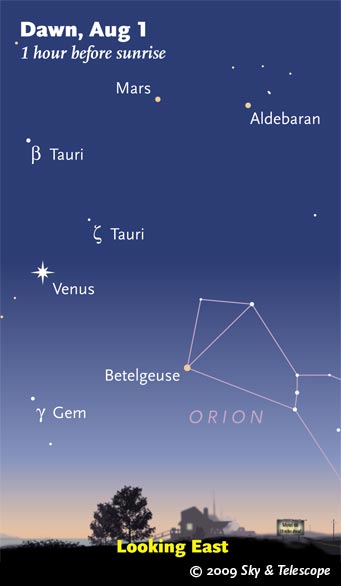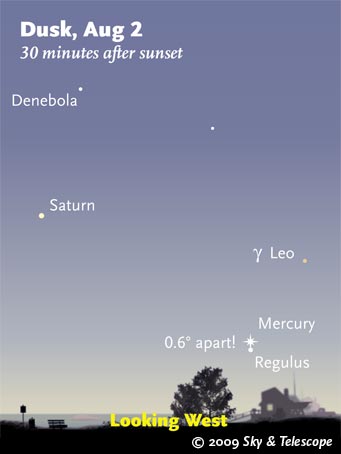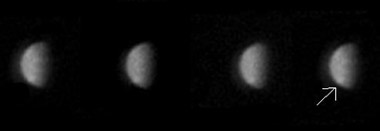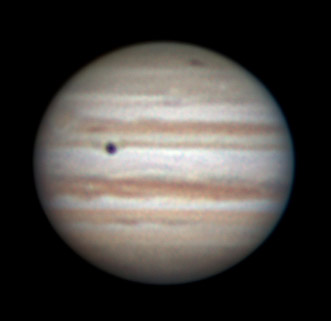Some daily events in the changing sky for July 31 – August 8.

Venus outshines all else in the early eastern dawn this week. Mars is more on a par with some of the bright stars in this early preview of "winter" constellations.
Sky & Telescope diagram
Friday, July 31
Saturday, August 1
Sunday, August 2
Monday, August 3
Tuesday, August 4

Bring binoculars to pick little Mercury and Regulus out of the sunset very low in the west. Good luck!
Sky & Telescope diagram
Wednesday, August 5
Thursday, August 6
Friday, August 7
Saturday, August 8
Want to become a better amateur astronomer? Learn your way around the constellations. They're the key to locating everything fainter and deeper to hunt with binoculars or a telescope. For an easy-to-use constellation guide covering the whole evening sky, use the big monthly map in each issue of Sky & Telescope diagram" target="new_window">Sky & Telescope, the essential magazine of astronomy. Or download our free Getting Started in Astronomy booklet (which only has bimonthly maps).
Sky Atlas 2000.0 (the color Deluxe Edition is shown here) plots 81,312 stars to magnitude 8.5. That includes most of the stars that you can see in a good finderscope, and typically one or two stars that will fall within a 50× telescope's field of view wherever you point. About 2,700 deep-sky objects to hunt are plotted among the stars.
Alan MacRobert
Once you get a telescope, to put it to good use you'll need a detailed, large-scale sky atlas (set of charts; the standards are Sky Atlas 2000.0 or the smaller Pocket Sky Atlas) and good deep-sky guidebooks (such as Sky Atlas 2000.0 Companion by Strong and Sinnott, the more detailed and descriptive Night Sky Observer's Guide by Kepple and Sanner, or the classic Burnham's Celestial Handbook). Read how to use them effectively.
Can a computerized telescope take their place? I don't think so — not for beginners, anyway, and especially not on mounts that are less than top-quality mechanically. As Terence Dickinson and Alan Dyer say in their Backyard Astronomer's Guide, "A full appreciation of the universe cannot come without developing the skills to find things in the sky and understanding how the sky works. This knowledge comes only by spending time under the stars with star maps in hand and a curious mind." Without these, "the sky never becomes a friendly place."
More beginners' tips: "How to Start Right in Astronomy".
This Week's Planet Roundup
Mercury (about magnitude –0.4) is having a poor apparition deep in the glow of sunset. Look for it very low in the west-northwest in bright twilight, as shown at the top of this page. Binoculars help.

The new white spot is arrowed in these ultraviolet stacked-video images of Venus taken by Frank Melillo a few minutes apart.
Frank Melillo
Venus (magnitude –4.0, in the feet of Gemini) blazes in the eastern sky before and during dawn.
As recently happened with Jupiter, an amateur planetary imager has found a newly-appeared marking on Venus! Frank Melillo of Holtsville, New York, discovered that Venus had unexpectedly grown a "Great White Spot" in ultraviolet light when he imaged it on the morning of July 19th, as shown here. Other amateur ultraviolet imagers soon confirmed it. The European Space Agency's Venus Express probe, currently orbiting Venus, has imaged the spot in detail. See New Scientist article for more.
Mars (magnitude +1.1, in the horns of Taurus) is well to the upper right of Venus before dawn. Not far to Mars's right or upper right is Aldebaran, a close match for it in both brightness and color. The two are 7° apart on August 1st, 10° apart by the 8th.

Jupiter's impact scar is the small dark mark in the planet's South Polar Region (top). The black dot on the edge of the South Equatorial Belt is the shadow of Callisto. Note the Great Red Spot just about to rotate out of sight on the celestial west limb (left). Sky & Telescope's Sean Walker used a 14.5-inch reflector for this stacked-video image 8:45 UT July 23, 2009.
The impact mark is near System II longitude 210°. To find the times of its future central-meridian crossings, add 2 hours and 6 minutes to our listed times of the Great Red Spot's transits. At least that's its approximate location; it may be moving a bit in longitude.
S&T: Sean Walker
Jupiter (magnitude –2.8, in Capricornus) shines low in the east-southeast during twilight. It's higher in better telescopic view in the southeast by midnight.
The impact on Jupiter. A black dust marking, like those made by the Comet Shoemaker-Levy 9 impacts in 1994, appeared suddenly in Jupiter's south polar region around July 18th. Since then it has been elongating. Backyard observers have been spotting it in 4-inch scopes during moments of steady atmospheric seeing. See our article.
Saturn (magnitude +1.1, in Leo) is getting very low in the west after sunset. Look early!
Saturn's rings may have vanished by the time you read this. They turn edge-on to the Sun and go black on August 9–10, visible only in silhouette against the planet's globe as a black hairline (if you get lucky with good atmospheric seeing). The rings turn edge-on to Earth on September 4th, but by then Saturn will be lost in the sunset.
Uranus (magnitude 5.8, just below the Circlet of Pisces), is high in the south before dawn.
Neptune (magnitude 7.8, in Capricornus) appears about 2° from Jupiter, but it's 17,000 times fainter. See our finder charts for Uranus and Neptune.
Pluto (14th magnitude, in northwestern Sagittarius) is highest in the south just after dark. See the finder chart in the June Sky & Telescope diagram" target="new_window">Sky & Telescope, page 53.
All descriptions that relate to your horizon or zenith — including the words up, down, right, and left — are written for the world's mid-northern latitudes. Descriptions that also depend on longitude (mainly Moon positions) are for North America. Eastern Daylight Time (EDT) equals Universal Time (also known as UT, UTC, or GMT) minus 4 hours.
To be sure to get the current Sky at a Glance, bookmark this URL:
http://SkyandTelescope.com/observing/ataglance?1=1
If pictures fail to load, refresh the page. If they still fail to load, change the 1 at the end of the URL to any other character and try again.
 0
0
Comments
You must be logged in to post a comment.